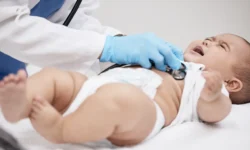How to prove medical negligence if your child is born with Bell’s palsy
After you’ve gone through labor and delivery, you expect to see your perfect baby. But what happens when your child suffers a birth injury during the process? What are your options and how can you receive monetary compensation for the damages?
At Brown Trial Firm, we specialize in birth injury lawsuits and we’re here to help you navigate this trying situation.
What is Bell’s palsy?
Bell’s palsy is weakness or paralysis of facial muscles that comes on suddenly for no apparent reason and becomes worse over 48 hours. It’s a result of damage or trauma to the 7th cranial facial nerve, and it usually causes significant facial distortion. Other symptoms of Bell’s palsy include:
- Excessive tearing of the eye
- Impairment of taste
- Dry mouth or eye
- Drooling
- Drooping corner of the mouth or eyelid
- Weakness and twitching
Discomfort and pain typically occur on one side of the head or face. Bell’s palsy strikes people of all ages, though it occurs most frequently in those with an upper respiratory ailment, a cold, the flu or diabetes and pregnant women. Bell’s palsy affects women and men equally.¹ The most common age range is people between the ages of 15 and 60.
Bell’s palsy is usually not permanent. But in rare cases, it doesn’t disappear. At present, there is no cure for Bell’s palsy. Recovery usually starts 2 weeks to 6 months from the onset of the symptoms. The majority of people recover with full facial expression and strength.²
How common is Bell’s palsy?
According to Harvard Health, approximately 1 in 70 people develop Bell’s palsy. It usually occurs only once.³ Nearly 40,000 people receive a Bell’s palsy diagnosis in the US each year⁴. It’s estimated to account for 60 to 75 percent of unilaterally acute facial paralysis.
The right side of the face is affected 63 percent of the time. Bell’s palsy reoccurs in 4 to 14 percent of individuals. Those with diabetes have a 29 percent higher risk of occurrence and are 30 percent more likely to only partially recover. Recurrence is also more common among patients with diabetes.⁵
Bell’s palsy treatment
Most people recover without treatment, but if necessary, mild electrical stimulation and massage of paralyzed muscles help prevent facial muscle function loss and maintain muscle tone. Oral corticosteroid drugs, like prednisone, have typically proven more successful than attempting surgery to widen the facial canal.
Goggles, eyeglasses, methylcellulose eye drops or a temporary patch help protect the exposed eye if they have difficulty closing it. In severe cases, a total or partial surgical eyelid closure on the affected side protects against permanent damage to the eye.
Bell’s palsy in infants
The causes of Bell’s palsy in infants include birth trauma or congenital factors, such as cold sores or the herpes virus. The mother can pass the infection onto the infant. Other causes include the flu or Epstein-Barr virus.
Some trauma-related causes of Bell’s palsy include:
- Forcep-assisted delivery
- Infant large for gestational age
- Prolonged labor
Doctors must carefully monitor infants with an infection, viral cold or diabetes since neonates with a virus or diabetes are more likely to develop Bell’s palsy. Knowing the risk factors and carefully monitoring the child are the best means of prevention.
If your child was born with Bell’s palsy that you feel was preventable with proper medical care, quick action is important. Getting help quickly means the infant gets the necessary treatment, therapy and care sooner. Consult an experienced birth injury lawyer to learn about your legal options. Every case is different. A knowledgeable lawyer will look at the facts and determine if medical negligence and malpractice were the culprits.
Entitlement of damages to parents
The joy of having a baby can be overshadowed when a birth trauma takes place. If a newborn sustains a birth injury due to a doctor’s carelessness or mistake, significant compensation for the parents is possible, depending on the circumstances. The range of birth injuries spans minor to severe.
Compensation for avoidable birth injuries includes medical bills, cost of assistive devices, loss of enjoyment of life, loss of future earnings, pain and suffering and more. Damages awarded vary based on the situation.
In rare cases, damages awarded punish the doctor for committing malpractice in an egregious manner rather than compensation for the harm caused. A highly skilled birth injury lawyer offers compassionate and competent representation to medical malpractice victims.
As a new parent, you might face tough questions like:
- Was the birth injury in some way preventable?
- Did the doctor or nurse make a mistake?
Cranial nerve injuries frequently result from medical malpractice, mainly when forceps were part of the delivery process. Doctors may commit errors and have lapses in judgment during a stressful childbirth. If a nurse or obstetrician makes a mistake during delivery, parents have a powerful range of legal options. Our dedicated legal team understands what parents go through, and we’re committed to holding all responsible parties accountable.
Reach out to Brown Trial Firm today to see if you have a case. Your first consultation is free.
Sources:
[1] https://rarediseases.info.nih.gov/diseases/5906/bells-palsy
[2] https://www.hopkinsmedicine.org/health/conditions-and-diseases/bells-palsy
[3] https://www.health.harvard.edu/pain/bells-palsy-overview
[4] https://rarediseases.org/rare-diseases/bells-palsy/
[5] https://emedicine.medscape.com/article/1146903-overview
- Cerebral Palsy
- Caput Succedaneum and Cephalohematoma
- Neonatal Intracranial Hemorrhage (Childbirth Brain Bleeds)
- Hydrocephalus (Extra Fluid in the Brain Cavity)
- Cervical Dystonia
- Hemiplegia (Brain or Spinal Cord Injury)
- Hemorrhagic Stroke
- Neonatal Stroke
- HIE
- Periventricular Leukomalacia (PVL) Brain Injury
- Infant Seizures
- Spastic Diplegia (Spasticity in the Legs)
- Top Risks for Birth Injuries
- Fetal Alcohol Syndrome
- Facial Paralysis
- Spinal Cord Injuries
- Bell’s Palsy
- Brachial Plexus Nerves & Erb’s Palsy
- Klumpke’s Palsy
- G-Tubes for Newborns
- Medical Errors
- Cesarean Section & Birth Injury
- Negligence in Brain Cooling Treatment
- Craniosacral Therapy
- Occupational Therapy
- Speech Therapy
- Transition From Pediatric to Adult Healthcare
- Surgical Options for Spastic Cerebral Palsy
- Fetal Intolerance to Labor
- Jaundice (Kernicterus)
- Breech Position
- Placental Complications
- Umbilical Cord Problems
- Uterine Rupture
- Cervical Incompetence (Insufficiency)
- Blighted Ovum
- Necrotizing Enterocolitis (NEC) - Intestinal Inflammation
- Cephalopelvic Disproportion
- Meconium Aspiration Syndrome
- Amniotic Fluid Embolism
- Birth Injury from Premature Delivery
- Developmental Delays
- Abnormal Cord Insertion
- Infections at Birth
- Chorioamnionitis Bacterial Infection
- Premature birth
- Oxygen Deprivation
- Listeria
- Birth-Acquired Herpes
- Placenta Previa
- Placental Abruption
- Mismanaged Fetal Malposition
- Rapid Labor
- Obesity Related Birth Injuries
- Intrauterine Growth Restriction
- Blood Clots During Pregnancy
- Ectopic Pregnancy Misdiagnosis
- Myths & Facts About Birth Injuries
- Bacterial Vaginosis
- Gestational Diabetes
- Maternal Mortality Risk
- Oligohydramnios (Low Amniotic Fluid)
- Infections During Pregnancy
- Excessive Bleeding During Pregnancy
- Congenital Syphilis


